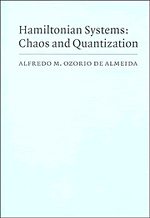2 - Nonlinear systems
Published online by Cambridge University Press: 05 July 2011
Summary
Little can be said that applies generally to nonlinear systems. We have access mainly to local results, such as the basic existence and uniqueness theorem, which establishes the possibility of rectifying vector fields. The conditions for the theorem exclude the neighbourhoods of equilibria, exactly the regions approximated by linear fields in chapter 1. This omission is filled in by the Hartman–Grobman theorem, which guarantees the existence of a coordinate transformation that linearizes a neighbourhood of generic points of equilibrium.
There follows a discussion of Poincaré sections. In principle they reduce the study of motion near a periodic orbit to the iterations of a map in the neighbourhood of a fixed point. The linear approximation near a fixed point was shown in chapter 1 to be equivalent to a linear flow. The nontrivial extension of the Hartman–Grobman theorem to maps thus provides information on the motion surrounding an important class of periodic orbits.
Poincaré sections reduce Hamiltonian systems to a map in a phase space with two fewer dimensions. That the map preserves symplectic area (just the area, in the case of the plane) is a consequence of the Poincaré–Cartan theorem, here derived from the variational principle. We will discuss the reduction of two dimensions for a Hamiltonian system, by making it periodic in time. In particular we will see how specific choices of coordinates may preserve some of the symmetry properties of the full system.
- Type
- Chapter
- Information
- Hamiltonian SystemsChaos and Quantization, pp. 24 - 47Publisher: Cambridge University PressPrint publication year: 1989

